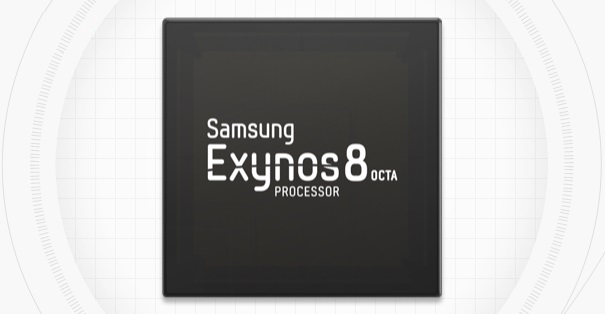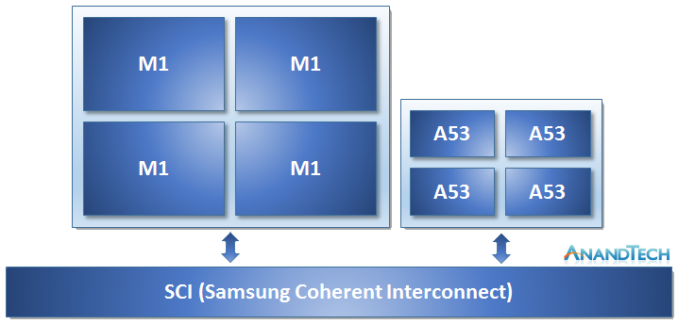Samsung Announces Exynos 8890 with Cat.12/13 Modem and Custom CPU
by Andrei Frumusanu on November 12, 2015 1:50 AM EST- Posted in
- Smartphones
- Samsung
- Mobile
- SoCs
- Exynos 8890
- Exynos M1

In an unexpected and surprise annoucement, Samsung today revealed its new generation flagship SoC - the Exynos 8. The Exynos 8890 to be more specific, is the successor to the Exynos 7420 that we've come to know very well in this year's Galaxy flagships such as the Galaxy S6 or the Note5.
The Exynos 8890 is still an 4+4 big.LITTLE design using four Cortex A53 cores in the little cluster, but on the big cluster we see for the first time Samsung's own custom developed CPU architecture deployed in silicon. The new core, officially called the Exynos M1, is the first fruit of years-long efforts by Samsung's Austin R&D Center to try to create an in-house CPU architecture. What we do know of the M1 is that it's still very similar to ARM's big core architectures (And thus might be a derivative) such as the A72: It's still a 3-wide OoO design with the same amount of execution pipelines and similar, although not quite identical pipeline stages on the execution units.
Samsung follows MediaTek's example by dropping the use of ARM's CCI IP in favour of designing their own cache-coherent interconnect fabric aptly named SCI (Samsung Coherent Interconnect). It seems that vendors are keen to try to improve their SoC architectures by designing fully optimized SoC fabric solutions and I guess Samsung saw the need to differentiate in this regard.
On the GPU side, we see usage of an ARM Mali T880MP12. This is the biggest Mali core implementation to date and increases the number of cores by 50% compared to the Exynos 7420's MP8 configuration. Keeping in mind that the T880 also increases ALU pipelines per core by 50%, we're looking at a 2.25x increase in computational power assuming Samsung kept the clock frequencies equal. Alternatively, they could go lower in frequency for much improved power efficiency. Samsung advertises 4K as an option for this SoC so likely we're looking at a very powerful GPU setup.
Lastly, but not least, is the announcement that the Exynos 8890 is part of Samsung's ModAP lineup, meaning this is a part with a modem. The new modem supports LTE Category 12 download speeds with up to 3x carrier aggregation up to 600Mbps or uploads speeds up to 150Mbps on Cat. 13 with CA. This effectively makes the new Shannon modem on the 8890 equal Qualcomm's Snapdragon 820 modem capabilities. Until further future confirmation on the matter, I fail to use the "integrated" word in regards to the modem due to Samsung's new product page presenting a graphic representing the modem/AP in a way that seems strikingly similar to a SiP (System-in-Package) solution, as opposed to an on-die solution.
The Exynos 8890 is announced to enter mass production in late 2015. With just six weeks left in the calendar year this likely means we're already seeing silicon being etched as we speak, just in time for Samsung's new Galaxy flagship early next year.
Source: Press release











56 Comments
View All Comments
colinisation - Thursday, November 12, 2015 - link
Wow, very suprising. Considering the comments by other manufacturers that phones are really not Gpu bound. Maybe wide and slow gives better power consumption.Andrei Frumusanu - Thursday, November 12, 2015 - link
Wide and slow is definitely more efficient, if that is indeed what they're doing here instead of going wide and fast.jjj - Thursday, November 12, 2015 - link
In part it is your fault. Nobody is testing actual games so they go for the marketing wins in empty benchmarks to match the itoys even if the GPU could might be overdimensioned.MP12 does seem like it should easily beat SD820 ,assuming T880 does as ARM claims.
Andrei Frumusanu - Thursday, November 12, 2015 - link
I've been quite harsh on the topic in the 7420 review and it's something I want to continue to actively address in the future.http://anandtech.com/show/9330/exynos-7420-deep-di...
jjj - Thursday, November 12, 2015 - link
I am unhappy about synthetic but got other complains too.In battery tests there are a bunch of factors that have a relevant impact but the biggest one in AT's case has to be the fact that you guys load a page every X mins while users browse in bursts. This means that the time the screen is on is very different in testing vs real world and renders the results irrelevant. Some other parts have different power consumption in this case too but the screen should be the biggest. Testing with nothing in the background makes it worse especially when you got a big difference in number and size of cores as well as RAM (less RAM is favored). Then there are huge differences in signal strength and when you test close to the signal source you favor the ones that have poor antennas and would do much worse when further away from the tower/router. Some of these ofc impact perf testing too. What pages are loaded matters too, aiming for just the home page of some popular sites is not ideal. Sites with the most individual users are not always the ones with most clicks. Home pages can be very different from other pages on the site. Users don't browse just very popular sites that tend to not be very heavy. And then there needs to be a balance between mobile and desktop versions.
Not testing signal strength is not good since it's important and there are huge differences.
Motion blur is a big problem in cams and OEMs as well as the press aren't educating users about it at all. In many cases users think exposure is about brightness and motion blur is self inflicted since the user just makes it brighter without knowing how it all works.
Just the few things that bug me the most, to keep it short.
MrSpadge - Thursday, November 12, 2015 - link
"... but got other complains too"Well, that's kind of self-explanatory in (almost) each of your posts. I'm not saying you're wrong, but you're certainly complaining a lot.
s.yu - Saturday, November 14, 2015 - link
I gotta agree on the signal strength. As for the web page loading, it may not be a good criteria at all, or at least should be put into consideration along with other criteria.edzieba - Thursday, November 12, 2015 - link
Not so surprising for Samsung, they've got GearVR releasing within a week. VR really needs more GPU grunt, so if they intend to continue GearVR for their next generation of phones, they need to focus on having a better GPU.darkich - Monday, November 16, 2015 - link
^thiszeeBomb - Thursday, November 12, 2015 - link
This is going to be one heck of a chipset. 12 cluster GPU, own custom cores... What more can 2016 ask for?